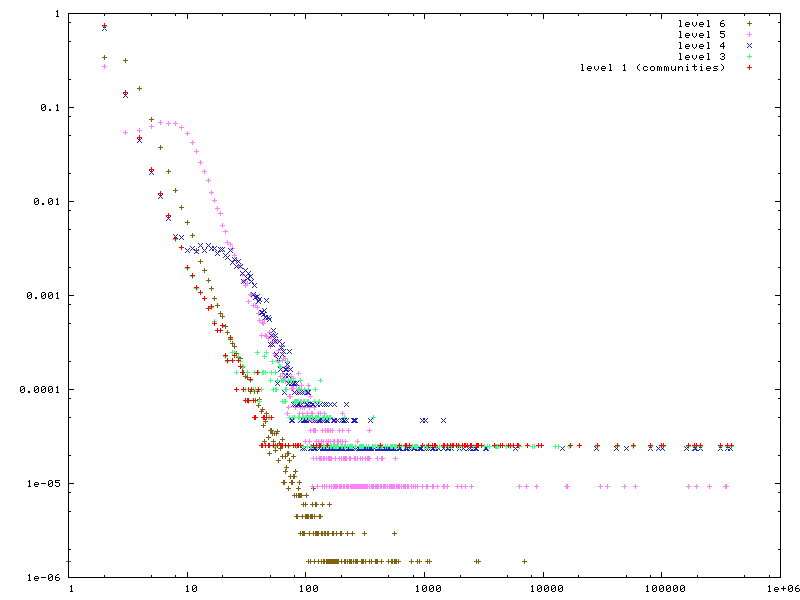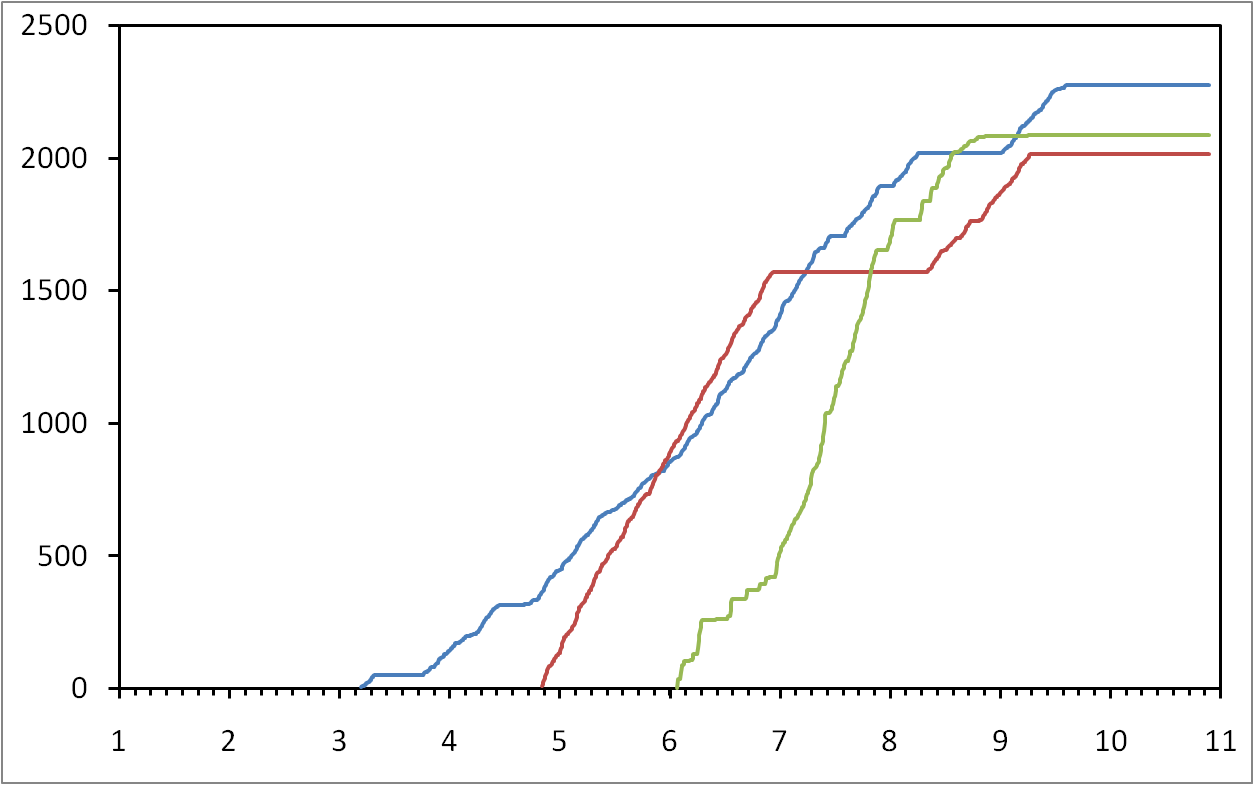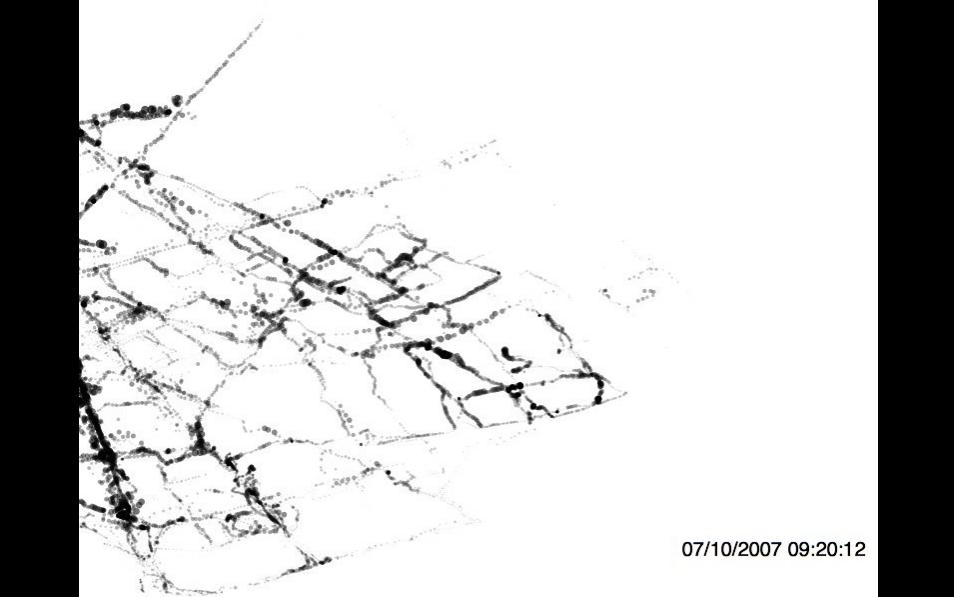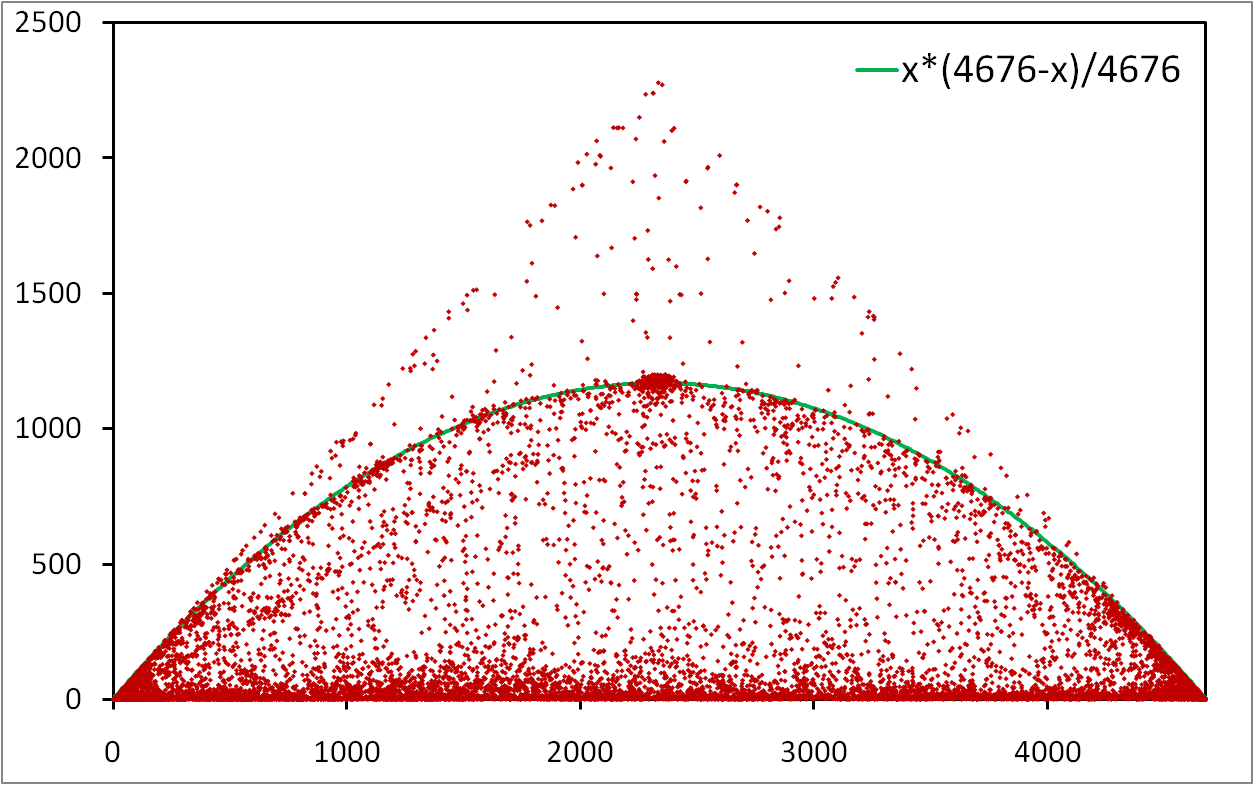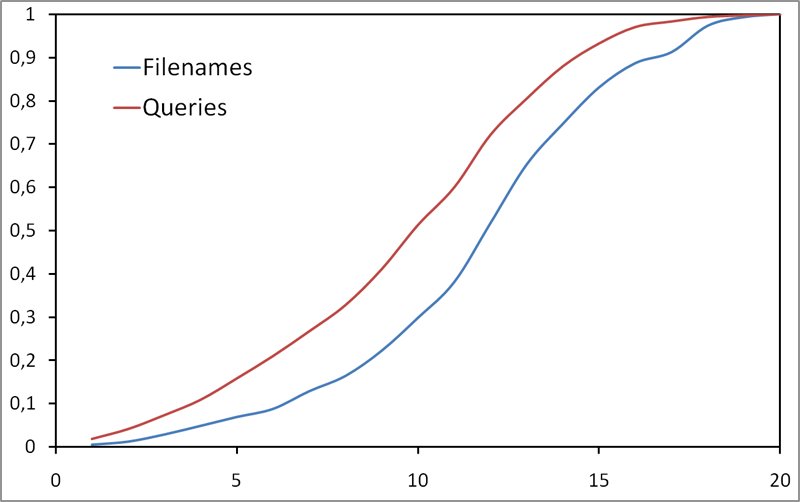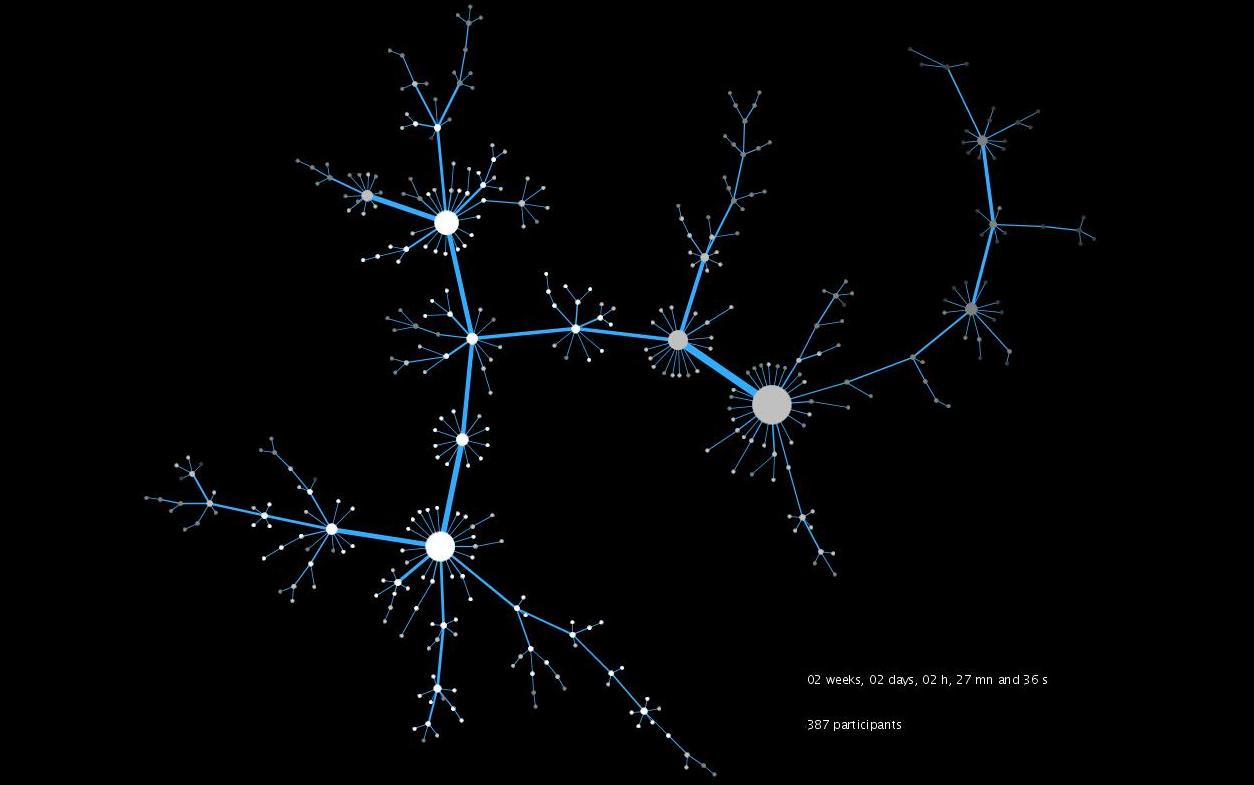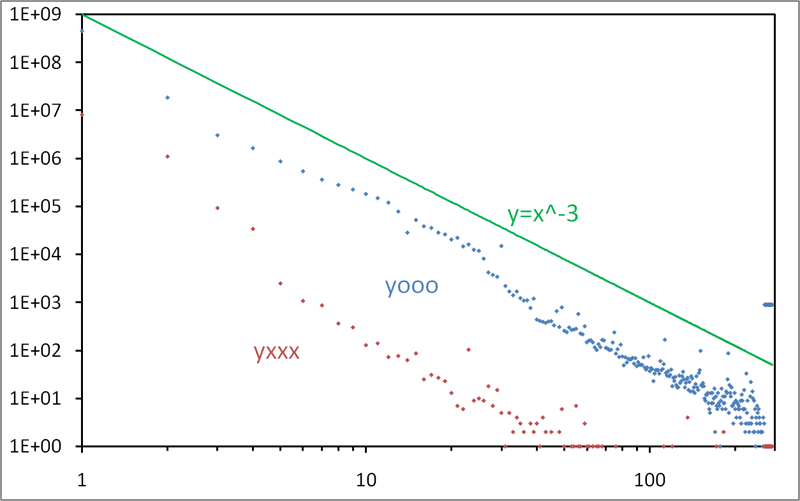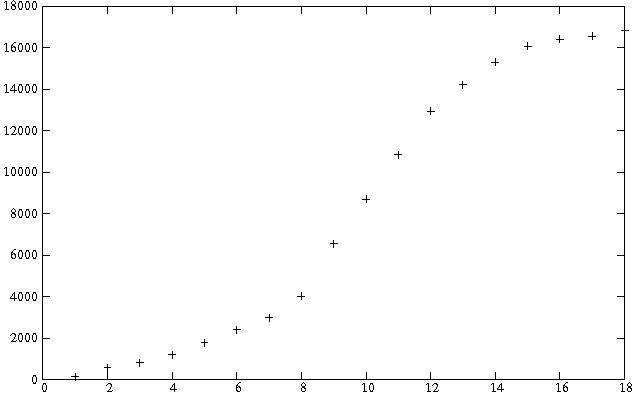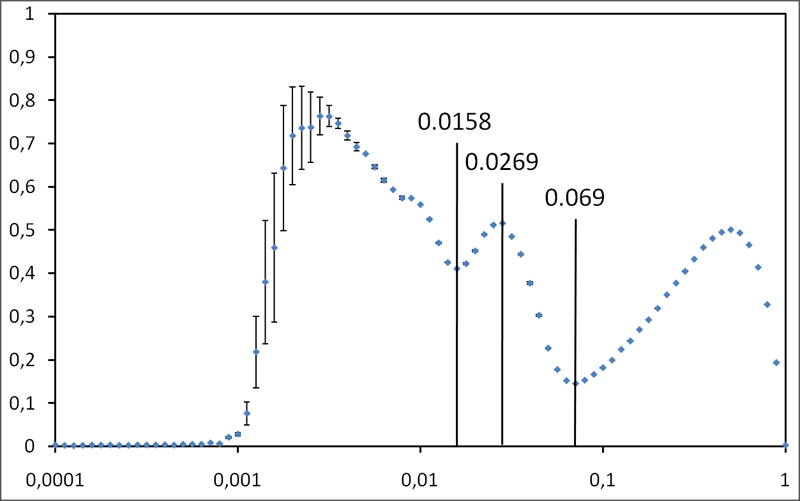Size distribution of communities at different scales
Download history of popular files
Daily Walks in Paris 13th: visualization of Wi-Fi access points
Dynamics of IP addresses around me
A Radar for the Internet
Matthieu Latapy, Clémence Magnien and Frédéric Ouédraogo
Proceedings of ADN’08: 1st International Workshop on Analysis of Dynamic Networks, in conjunction with IEEE ICDM 2008
In contrast with most internet topology measurement research, our concern here is not to obtain a map as complete and precise as possible of the whole internet. Instead, we claim that each machine’s view of this topology, which we call ego-centered view, is an object worth of study in itself. We design and implement an ego-centered measurement tool, and perform radar-like measurements consisting of repeated measurements of such views of the internet topology. We conduct long-term (several weeks) and high-speed (one round every few minutes) measurements of this kind from more than one hundred monitors, and we provide the obtained data. We also show that these data may be used to detect events in the dynamics of internet topology.
Ages in queries and filenames
Fast Computation of Empirically Tight Bounds for the Diameter of Massive Graphs
Clémence Magnien, Matthieu Latapy and Michel Habib
ACM Journal of Experimental Algorithmics (JEA), 13, 2009
The diameter of a graph is among its most basic parameters. Since a few years, it moreover became a key issue to compute it for massive graphs in the context of complex network analysis. However, known algorithms, including the ones producing approximate values, have too high a time and/or space complexity to be used in such cases. We propose here a new approach relying on very simple and fast algorithms that compute (upper and lower) bounds for the diameter. We show empirically that, on various real-world cases representative of complex networks studied in the literature, the obtained bounds are very tight (and even equal in some cases). This leads to rigorous and very accurate estimations of the actual diameter in cases which were previously untractable in practice.
Fast unfolding of communities in large networks
Vincent D. Blondel, Jean-Loup Guillaume, Renaud Lambiotte, Etienne Lefebvre
J. Stat. Mech. (october 2008) P10008
We propose a simple method to extract the community structure of large networks. Our method is a heuristic method that is based on modularity optimization. It is shown to outperform all other known community detection method in terms of computation time. Moreover, the quality of the communities detected is very good, as measured by the so-called modularity. This is shown first by identifying language communities in a Belgian mobile phone network of 2.6 million customers and by analyzing a web graph of 118 million nodes and more than one billion links. The accuracy of our algorithm is also verified on ad-hoc modular networks
Description and simulation of dynamic mobility networks
Pierre Borgnat, Eric Fleury, Jean-Loup Guillaume, Céline Robardet and Antoine Scherrer
Computer Networks 52 (2008), pp. 2842-2858
During the last decade, the study of large scale complex networks has attracted a substantial amount of attention and works from several domains: sociology, biology, computer science, epidemiology. Most of such complex networks are inherently dynamic, with new vertices and links appearing while some old ones disappear. Until recently, the dynamic of these networks was less studied and there is a strong need for dynamic network models in order to sustain protocol performance evaluations and fundamental analyzes in all the research domains listed above. We propose in this paper a novel framework for the study of dynamic mobility networks. We address the characterization of dynamics by proposing an in-depth description and analysis of two real-world data sets. We show in particular that links creation and deletion processes are independent of other graph properties and that such networks exhibit a large number of possible configurations, from sparse to dense. From those observations, we propose simple yet very accurate models that allow to generate random mobility graphs with similar temporal behavior as the one observed in experimental data.
P2P clients contacting a honeypot
Spreading of the Happy Flu experiment
Evolving networks
Pierre Borgnat, Eric Fleury, Jean-Loup Guillaume, Clémence Magnien, Céline Robardet et Antoine Scherrer
Proceedings of NATO Advanced Study Institute on Mining Massive Data Sets for Security, IOS Press, 2008
Most real networks often evolve through time: changes of topology can occur if some nodes and/or edges appear and/or disappear, and the types or weights of nodes and edges can also change even if the topology stays static. Mobile devices with wireless capabilities (mobile phones, laptops, etc.) are a typical example of evolving networks where nodes or users are spread in the environment and connections between users can only occur if they are near each other. This whois- near-whom network evolves every time users move and communication services (such as the spread of any information) will deeply rely on the mobility and on the characteristics of the underlying network. This paper presents some recent results concerning the characterization of the dynamics of complex networks through three different angles: evolution of some parameters on snapshots of the network, parameters describing the evolution itself, and intermediate approaches consisting in the study of specific phenomena or users of interest through time.
Basic Notions for the Analysis of Large Two-mode Networks
Matthieu Latapy, Clémence Magnien and Nathalie Del Vecchio
Social Networks (2008), vol. 30, no1, pp. 31-48
Many large real-world networks actually have a 2-mode nature: their nodes may be separated into two classes, the links being between nodes of different classes only. Despite this, and despite the fact that many ad-hoc tools have been designed for the study of special cases, very few exist to analyse (describe, extract relevant information) such networks in a systematic way. We propose here an extension of the most basic notions used nowadays to analyse large 1-mode networks (the classical case) to the 2-mode case. To achieve this, we introduce a set of simple statistics, which we discuss by comparing their values on a representative set of real-world networks and on their random versions. This makes it possible to evaluate their relevance in capturing properties of interest in 2-mode networks.
Detection, Understanding, and Prevention of Traceroute Measurement Artifacts
Fabien Viger, Brice Augustin, Xavier Cuvellier, Clémence Magnien, Matthieu Latapy, Timur Friedman, and Renata Teixeira
Computer Networks 52-5 (2008), pp. 998-1018. Extended abstract published in the proceedings of the 6-th Internet Measurement Conference IMC’06, 2006, Rio de Janeiro, Brazil
Test of time award IMC 2022
Traceroute is widely used: from the diagnosis of network problems to the assemblage of internet maps. Unfortunately, there are a number of problems with traceroute methodology, which lead to the inference of erroneous routes. This paper studies particular structures arising in nearly all traceroute measurements. We characterize them as « loops », « cycles », and « diamonds ». We identify load balancing as a possible cause for the appearance of false loops, cycles and diamonds, i.e., artifacts that do not represent the internet topology. We provide a new publicly-available traceroute, called Paris traceroute, which, by controlling the packet header contents, provides a truer picture of the actual routes that packets follow. We performed measurements, from the perspective of a single source tracing towards multiple destinations, and Paris traceroute allowed us to show that many of the particular structures we observe are indeed traceroute measurement artifacts.
Complex Network Measurements: Estimating the Relevance of Observed Properties
Matthieu Latapy and Clémence Magnien
Infocom’08 Proceedings, Phoenix, USA
Complex networks, modeled as large graphs, received much attention during these last years. However, data on such networks is only available through intricate measurement procedures. Until recently, most studies assumed that these procedures eventually lead to samples large enough to be representative of the whole, at least concerning some key properties. This has crucial impact on network modeling and simulation, which rely on these properties. Recent contributions proved that this approach may be misleading, but no solution has been proposed. We provide here the first practical way to distinguish between cases where it is indeed misleading, and cases where the observed properties may be trusted. It consists in studying how the properties of interest evolve when the sample grows, and in particular whether they reach a steady state or not. In order to illustrate this method and to demonstrate its relevance, we apply it to data-sets on complex network measurements that are representative of the ones commonly used. The obtained results show that the method fulfills its goals very well. We moreover identify some properties which seem easier to evaluate in practice, thus opening interesting perspectives.
The yooooo distribution
Local leaders in random networks
Vincent D. Blondel, Jean-Loup Guillaume, Julien M. Hendrickx, Cristobald de Kerchove and Renaud Lambiotte
Phys. Rev. E 77, 036114 (2008)
We consider local leaders in random uncorrelated networks, i.e., nodes whose degree is higher than or equal to the degree of all their neighbors. An analytical expression is found for the probability for a node of degree k to be a local leader. This quantity is shown to exhibit a transition from a situation where high-degree nodes are local leaders to a situation where they are not, when the tail of the degree distribution behaves like the power law ~k^gamma_c with gamma_c=3. Theoretical results are verified by computer simulations, and the importance of finite-size effects is discussed.


